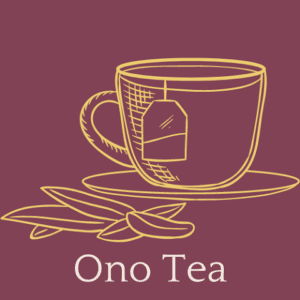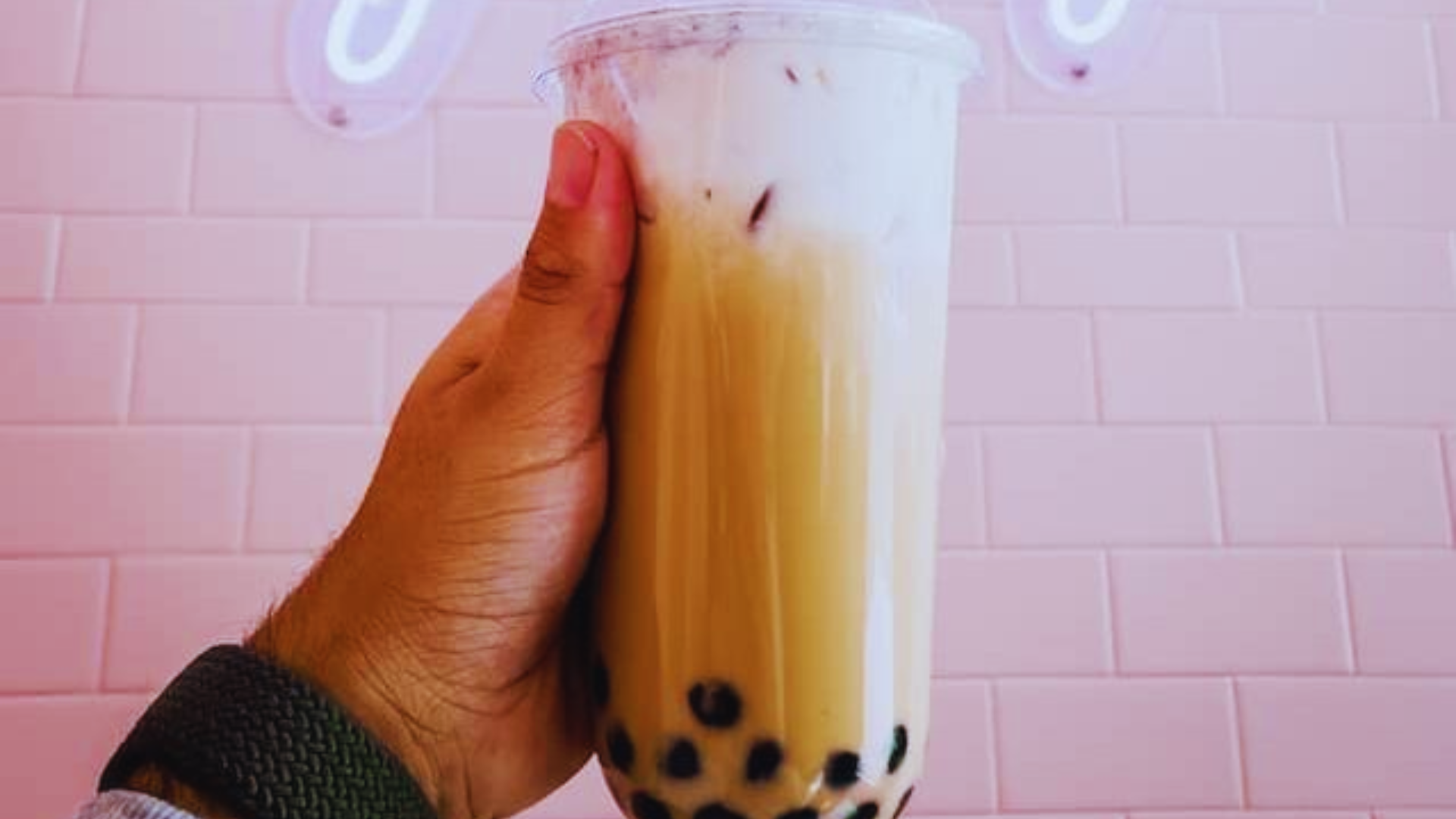Milk tea, or bubble tea, is simply a combination of tea and milk. It is a popular drink in the culinary arts industry. Over the years, people have put out various milk tea flavors with different ways of preparation for consumption.
Some examples of popular milk teas include Hokkaido milk tea, Thai tea, Hong Kong milk tea, and the ever-delicious Okinawa milk tea, which is very popular in Japan.
Okinawa milk tea comes from the Okinawa prefecture. It is a milk tea variant or flavor originating from Japan. It is a sweet combination of black tea, milk, and a sweetener. Okinawa milk tea gets its outstanding taste from the island’s brown sugar. It is usually consumed hot but can also be iced and served along with tapioca pearls or boba.
In this article, we’ll be learning more about Okinawa milk tea, its ingredients, its health benefits, and its preparation method. Moreover, you will learn other essential information regarding this fantastic Japanese tea.
Read on as we disclose what Okinawa milk tea is and the hidden (but not so hidden) secret behind it.
Ingredients for Making Okinawa Milk Tea
To prepare Okinawa milk tea, the following ingredients are essential:
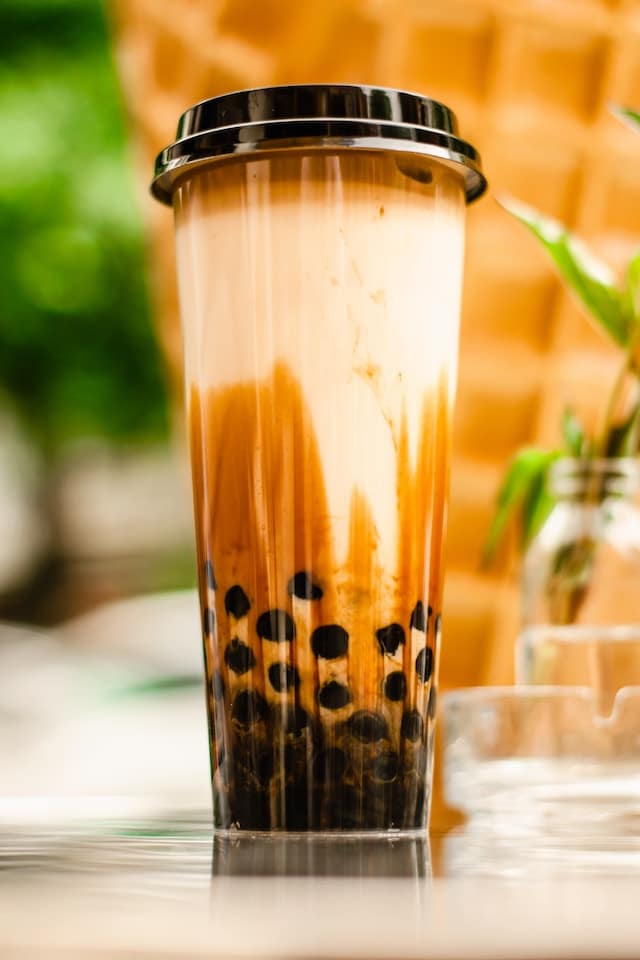
• Loose-leaf Black Tea
Most cafes use regular milk tea powder to make Okinawa milk tea. However, it is preferable to use loose-leaf black tea. This is because they improve the flavor of this particular milk tea by giving it a unique, tangy taste. Assam tea ranks as the best tea to use for this purpose. However, you can try others, such as Earl Grey tea or English breakfast.
• Premium Quality Milk
Whole milk is the appropriate milk for making this refreshing drink. Nevertheless, you can opt for other milk variants without whole milk. Whole milk gives the drink an enjoyable, creamy texture.
• Kokuto (Okinawa Brown Sugar)
This is the icing on the cake! For this recipe to be complete, Okinawa brown sugar is necessary. It gives the milk tea a malty and delicious taste. Moreover, the sweetness of this Japanese brown sugar balances the flavor of the loose-leaf black tea. A suitable alternative to kokuto is gula melaka, or Thai coconut palm sugar. However, if this is unavailable, you can use any regular brown sugar, molasses, or roasted sugar.
• Tapioca Pearls, Milk Tea Classic Okinawa Powder, and Ice
These can also be included as part of the ingredients in Okinawa milk tea. All these help to augment the quality of Okinawa milk tea. However, these ingredients are entirely optional.
How to Make Okinawa Milk Tea
You can make Okinawa milk tea at the convenience of your home using available kitchen equipment. It is effortless to make, and the resulting drink and taste are worthwhile.
We will show you two ways you can achieve this mouth-watering drink.
Method 1: The Straightforward Method
- Boil some water: You can use a pot, an electric kettle, or a stovetop kettle to achieve this. Put some clean water on fire and heat until you thoroughly boil it.
- Measure your loose-leaf tea leaves: For every six ounces of boiling water, use one teaspoon of loose-leaf tea leaves. A teapot or infuser is most appropriate as it gives the leaves room to produce more flavor.
- Brew your loose-leaf tea leaves: When the water is well heated, pour it over and leave for four to five minutes to infuse your tea leaves. After brewing, sieve into a suitable cup.
- Add your sweetener: Add your kokuto, Okinawa brown sugar, or whatever suitable sweetener you have to taste and give it a little stir.
- Stir: Finally, pour your whole milk into this mixture and stir till there’s an even distribution. If you want to go extra, heat your milk before adding it.
Note: You can ice your tea and add tapioca pearls. However, this is optional.
Method 2: The Syrup and Tapioca Pearls Method
- Prepare your syrup: Place a saucepan on low to medium heat, pour 2 cups of water, and leave to boil. Afterward, add the Okinawa brown sugar and stir. Keep stirring till the sugar has melted thoroughly. Check for thickness and stickiness. If it’s thick and sticky, it means your milk tea syrup is ready. Typically, this process takes 5 to 6 minutes.
- Heat the tapioca pearls: Place your stove on low heat and boil 2 cups of water. After, add in your tapioca pearls and let them boil. Cook until mildly translucent. Once they rise, check for softness and drain excess water. Add these tapioca pearls to your syrup.
- Prepare your tea: Finally, boil two cups of water in a kettle on medium heat and add loose-leaf tea leaves to brew for four to five minutes. Strain the leaves and pour the contents into a cup. Add your whole milk or any milk of your choice and stir. Next, slowly add the sugar syrup with the pearls mixture and consume as soon as possible.
Things to Note While Making Okinawa Milk Tea
- Refrain from brewing your tea leaves over a long period. Doing this will make your tea too bitter for consumption, and the purpose of use becomes defeated.
- Constantly check for sweetness to prevent going overboard by adding too much kokuto.
How the Okinawa Milk Tea Tastes
Due to the ingredients in Okinawa milk tea, it has a sweet taste with a mild and smooth tang. The commonly used Assam tea has a robust flavor, and creamy milk and Okinawa dark brown sugar blend it.
Kokuto (Okinawa Brown Sugar): The Mystery Behind the Okinawa Milk Tea Taste
Kokuto, also known as Okinawa brown sugar, gives Okinawa milk tea its authentic taste. This brown sugar results from a unique method of preparation; boiling down pure sugarcane juice.
This process results in edible, dark-colored toasted sugar with rich mineral contents and an authentic flavor. Moreover, this preparation method makes it more nutritious than common brown sugars in America.
The Japanese consider Okinawa brown sugar to be very healthy. Therefore, they use it to make dishes like sweet soups and milk teas.
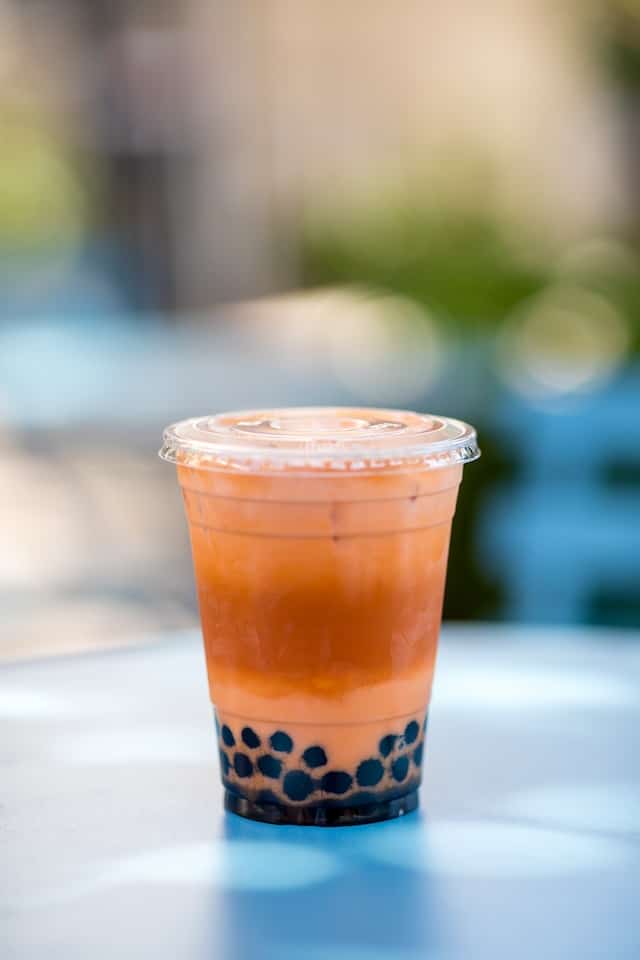
Nutritional Value and Health Benefits of Drinking Okinawa Milk Tea
24 oz of Okinawa milk tea contains 324 calories, 59g of carbs, 14g fat, and 1g protein.
Okinawa milk tea is high in vitamins and minerals, which may help reduce the risk of diabetes and enhance blood sugar levels. Okinawa milk tea has high antioxidant properties that shield the body’s cells from damage. Furthermore, it is a way of getting calories into the body. Moreover, people of various ages can enjoy it.
Other Common Types of Milk Tea
• Hong Kong Milk Tea
This is a combination of black tea, evaporated or condensed milk, and an optional sweetener. This drink signifies a unification of the British and Hong Kong tea cultures. While British milk tea uses fresh milk in its preparation, Hong Kong milk tea uses condensed or evaporated milk.
• Hokkaido Milk Tea
This milk tea gets its name from Hokkaido in Japan. Hokkaido milk tea is a brew of loose-leaf tea, milk from the Hokkaido region, and a sweetener.
Hokkaido milk tea also goes as Royal milk tea or Nidashi milk tea. Without Hokkaido milk, you can use milk and cream, fat milk, and plant-based milk, like oat milk and almond milk to achieve this milk tea. Sweetener substitutes include roasted brown sugar, caramel, or honey.
• Thai Tea
This is a simple blend of tea, milk, and sugar. You can serve it as iced tea and flavor it with ingredients such as star anise, lime, and mint.
• Masala Chai
This local chai drink contains quality Ceylon tea, cardamom, cinnamon, ginger root, and cloves blended. This results in a spicy taste but can be sweetened using milk and honey for a classic taste.
• British Cuppa
Local breakfast blends such as English breakfast are normally used to achieve this milk tea. Tea lovers in Ireland and the United Kingdom take this drink alone with milk and seldom with sweeteners.
Other milk teas include tea lattes and boba etc.
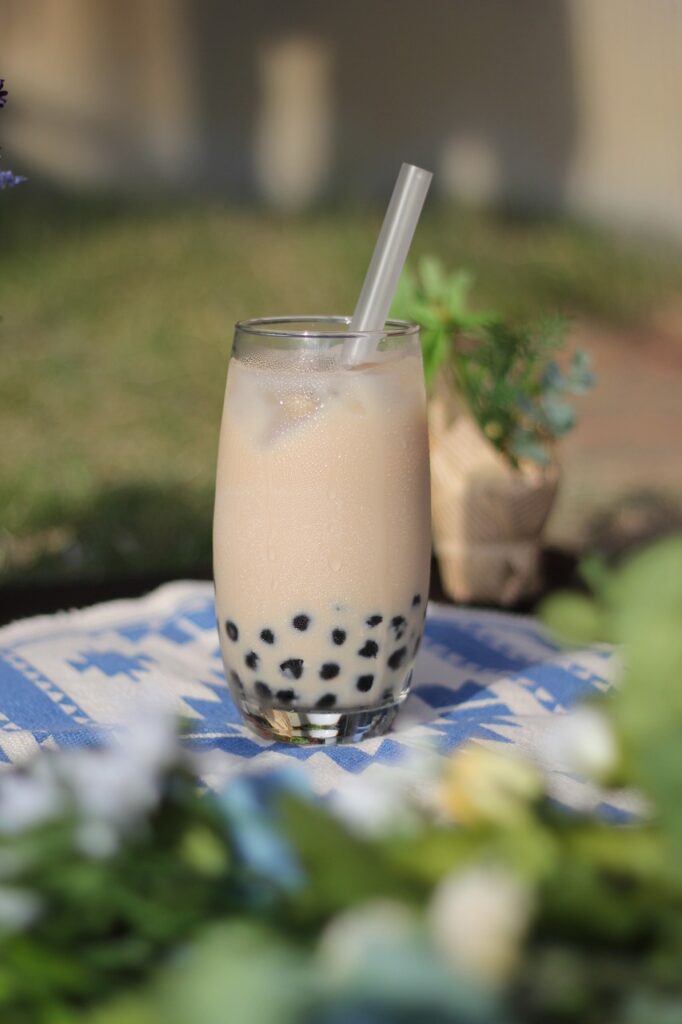
Caffeine Content in Okinawa Milk Tea
Generally, using local black tea bases results in contents high in caffeine. The level of caffeine present in your milk tea depends on various factors. A few of them include the following:
• Brewing duration
The longer you brew your tea leaves, the higher and stronger the caffeine level. However, infusing for three to five minutes is enough to achieve what you want.
• Temperature
The temperature of the water used in the process is also a determinant. The hotter the water used in infusing, the higher the caffeine level.
• Size of leaf
For a robust cup of Okinawa milk tea, you can use broken tea leaves
Frequently Asked Questions (FAQs)
1. Is Okinawa milk tea the same as Hokkaido milk tea?
These milk teas are similar as they also share some base ingredients. However, each of them has different traditional components that distinguish them. For Okinawa milk tea, there is Okinawa brown sugar (kokuto), the core ingredient. Alternatively, Hokkaido milk tea uses creamy milk from the Hokkaido province of Japan. You can characterize these milk teas based on these key ingredients even though you can make them using other milk variants and regular brown sugar.
2. Is Okinawa milk tea healthy for consumption?
The Okinawa brown sugar or kokuto present in the Okinawa milk tea makes it one of the healthiest milk teas available. Brown sugar is high in vitamins and minerals and is generally very nutritious. It also contains whole milk, which also has high nutritional value.
3. How long can I store Okinawa milk tea?
You cannot store Okinawa milk tea for too long. You should consume the milk tea as soon as you make it. However, you can keep it for up to two hours if you don’t plan on drinking it immediately.
4. Where can I get kokuto or Okinawa brown sugar?
You can get Okinawa brown sugar from specific food shops. If you do not have such outlets, you can make your toasted brown sugar or use regular brown sugar to make your Okinawa milk tea.
5. What can you take Okinawa milk with?
You can take Okinawa milk tea with tapioca pearls.
6. What is the difference between Okinawa milk tea and Thai milk tea?
Okinawa milk tea comes from loose-leaf tea leaves. However, Thai leaf comprises green tea leaves. Thai milk tea usually has a creamier texture than Okinawa milk tea because of the condensed or evaporated milk in it.
Concluding Thoughts
Okinawa milk tea is a very delicious drink you can try out at home. Moreover, you can easily source the ingredients. Furthermore, you can even improvise. However, we advise that you endeavor to get the Okinawa brown sugar as it gives the Okinawa milk tea powder mix its unique taste, as regular brown or refined white sugar may not accurately achieve this.
Okinawa brown sugar offers excellent health benefits, and you can enjoy your tea even on a hot day. Therefore, if you find yourself in Japan, get a cup of this milk tea. If you are looking for a new flavor of milk tea, Okinawa milk teas are a go-to.
We wish you a pleasant time savoring your mouth-watering Okinawa milk drink!
